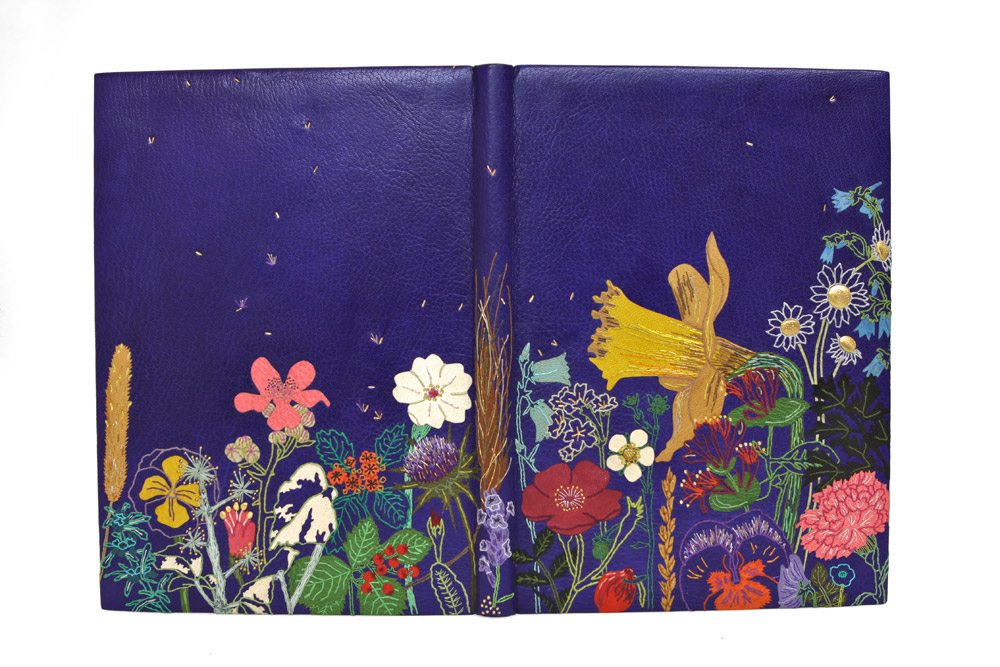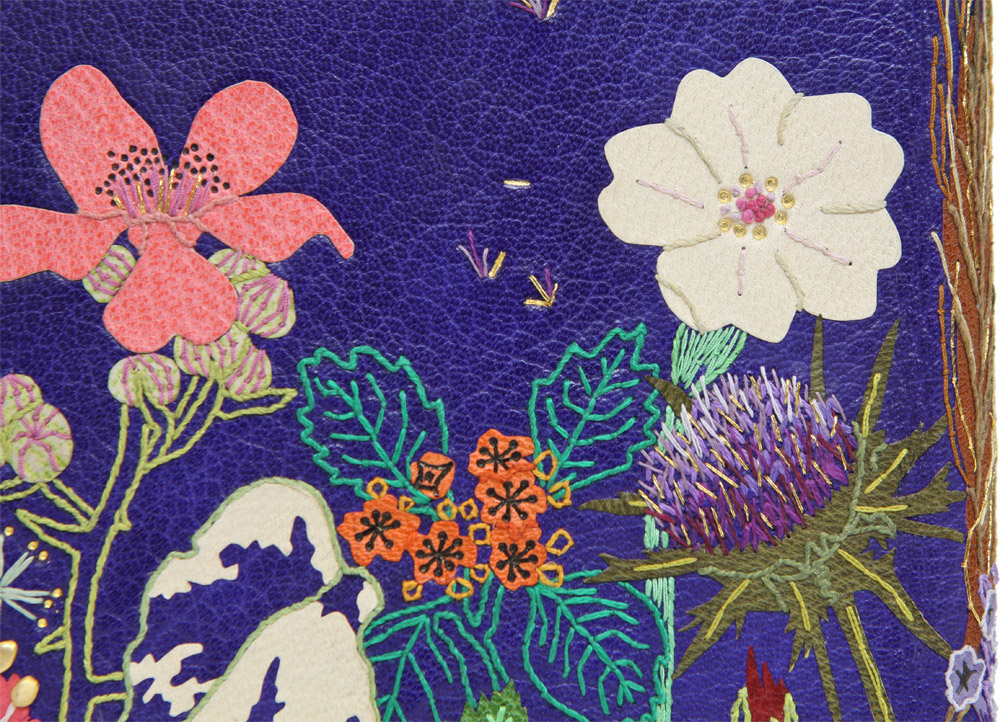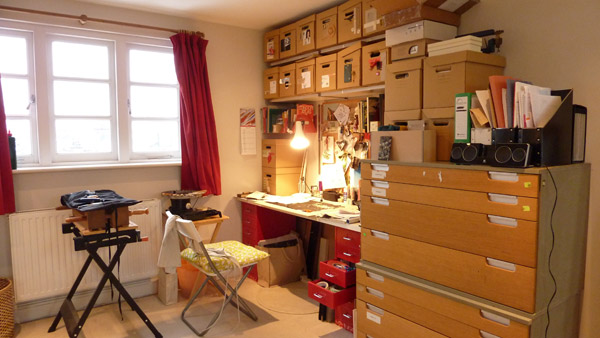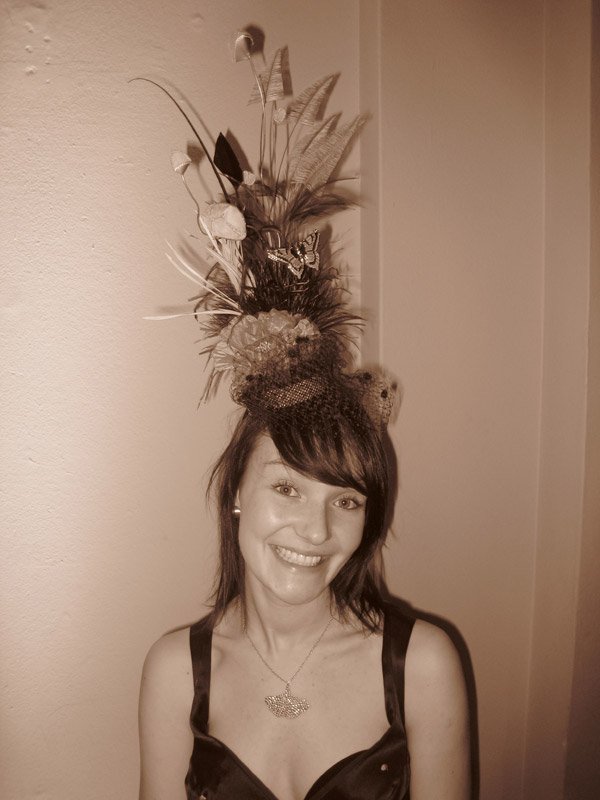This gorgeous fine binding was bound by Hannah Brown for the 2012 Designer Bookbinders International Competition. The theme of the competition was Shakespeare. Bound in full purple goatskin is a 1906 edition of Flowers from Shakespeare’s Garden: A Posy From the Plays with illustration from Walter Crane. The book contains quotes from various Shakespearean plays, each one containing the name of a flower. Walter Crane beautifully illustrates figures dressed in garments inspired by the flowers mentioned. Each flower in the book appears somewhere on the cover, doublure and endpaper design.
The leather is embroidered over various colored leather onlays using a variety of silk and metallic threads. There are nine gold plated brass pieces attached to the boards. Using handmade finishing tools, Hannah further embellishes the cover with carbon and gold.
The endpapers and doublure design was done using soft-plate off-set printing and embellished with additional embroidery and tooling.
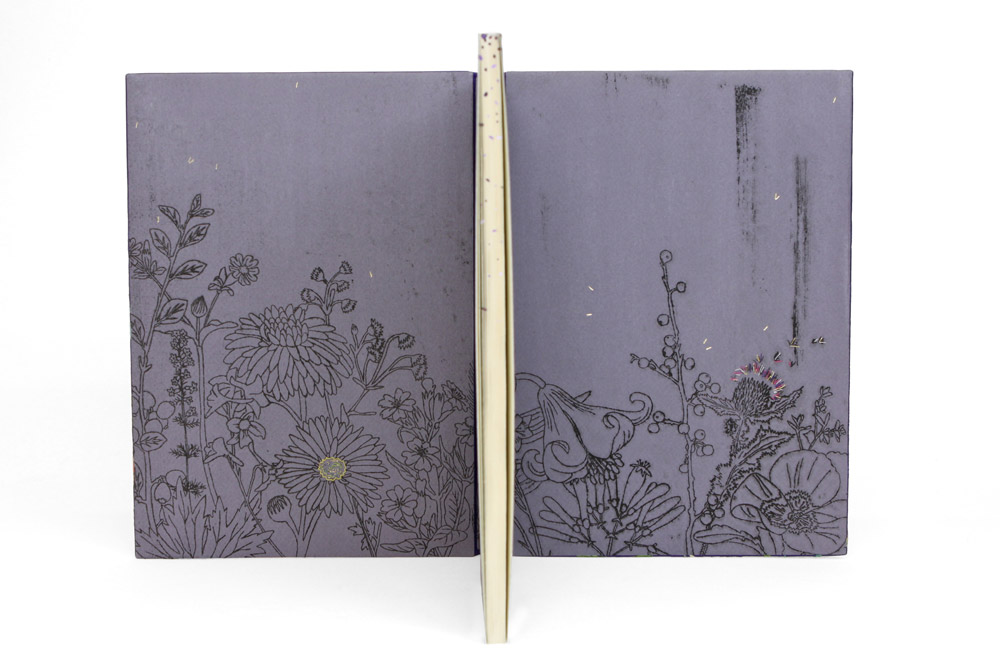
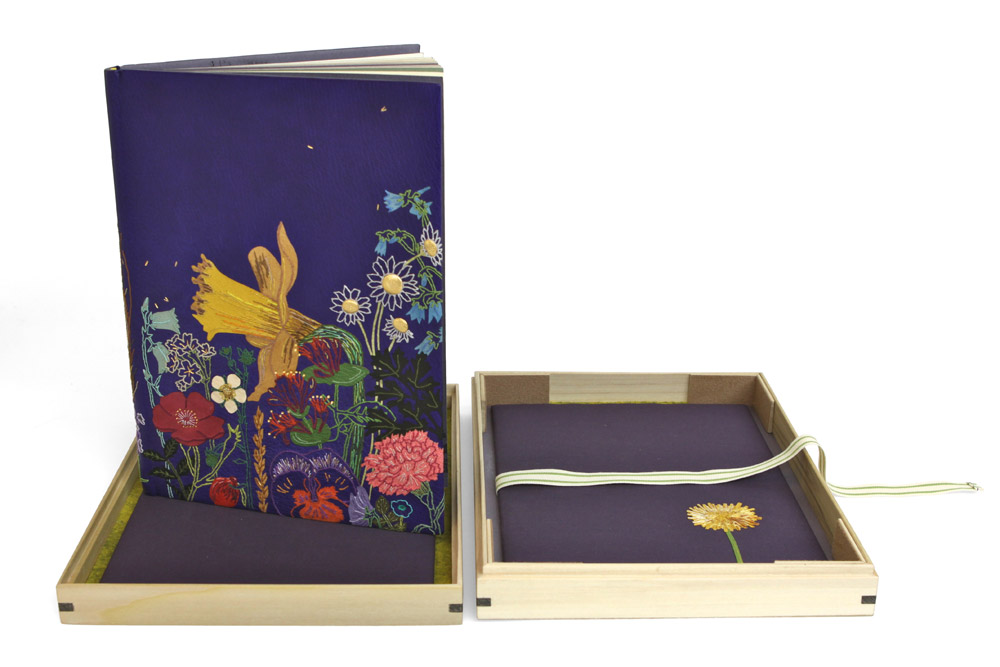 The binding is housed in a tulipwood box, mitered and held together with bog oak keys. A floral line drawing was etched into the lid of the box with a computer-controlled router. Pads are placed inside the box for added protection, the bottom pad was embroidered with a single flower.
The binding is housed in a tulipwood box, mitered and held together with bog oak keys. A floral line drawing was etched into the lid of the box with a computer-controlled router. Pads are placed inside the box for added protection, the bottom pad was embroidered with a single flower.
Hannah specializes in fine binding and custom commissioned pieces, working with a variety of materials and found objects; inspired by her habit of collecting. Check out the interview below to find out how Hannah got into bookbinding and come back every Sunday this month for more fine bindings.
You graduated from Brighton University in 2004 with a BA (Hons) in Three Dimensional Craft. Can you explain your studies, what type of medium(s) did you work in and what materials were you using?
My degree was nicknamed ‘WMCP’, standing for wood, metal, ceramics and plastics. It was a three-year degree, in the first year we rotated through the four materials learning basic making skills including wood-turning, silver soldering, mould-making and casting in resin. In our second year we had to specialise in two materials so I chose metal and ceramics and went on to make jewellery for my third year degree show.
When were you first introduced into bookbinding and what was your attraction to it? Can you also talk about your first instructors and the training you had?
At the Brighton University Grand Parade site, there were many different art-related degree courses running including Graphic Design, Illustration, Sculpture and Fashion. There was a permanent bookbinding studio that students could use as part of their studies if they were doing the Graphics and Illustration courses, however I was not permitted to as my degree course fell under a different department.
I remember a fellow student on my course showing me some bindings she had made whilst doing bookbinding evening classes in her final study year. I was very impressed by the books she had made and decided to sign up for an evening class myself once I had graduated. At the time I was lucky enough to be working in Brighton for two different jewellers, improving on the metal working skills I learnt whilst doing my degree.
I signed up to a beginner’s class and my first tutor was Peter Jones (a current Fellow and past President of Designer Bookbinders). We began by making a simple single-section book and then a few weeks later progressed on to making a multi-section, case-binding. I was hooked from pretty much class one, delighting in the fact that I had made my own little notebook!
Due to my fascination with collecting, which developed during my degree course, I took it further and starting stitching found objects to my book covers. I moved from Brighton a few months after I graduated but was fortunate to carry on going to bookbinding evening classes at The Institute in North London, an adult education college. My tutor there was Chris Damp, a trained book conservator, and this is where I first began to learn how to work with leather.
You were elected as a Licentiate member of the Designer Bookbinders in 2009. Congratulations! You’ve been assigned two mentors, can you talk about this experience and what opportunities have arose from this honor?
I applied to be a Licentiate member of Designer Bookbinders after winning the Mansfield Medal in the 2008 Annual Competition for my binding of Daphne Du Maurier’s, ‘Don’t Look Now and Other Stories’. I was thrilled and it was suggested by other bookbinders that I apply.
I was assigned both Peter Jones, my first bookbinding tutor from Brighton, and Jenni Grey (also from Brighton) as my mentors. They were chosen specifically for me as it was felt their work had specific relevance to mine. I use a lot of embroidery and sewn detail in my work, as does Jenni, and I am also trying to develop ways to use other materials (such as wood, metal and acrylic) into my bindings, which Peter does a lot of.
The fact that both my mentors live in Brighton is fantastic as I love going down to see them, and reminiscing about by university days. In the four years that they have been my mentors I have been to see them about three times. Each time I have tried to take along work in progress as the most useful feedback I can get is during the making progress, when it is easiest to see how the book is functioning beneath the leather cover. I am able to ask other Fellows for advice too, which is an invaluable tool.
One of the main opportunities that have arisen since being elected as a Licentiate, has been the chance to regularly exhibit my work alongside the other Fellows and Licentiates. I am also surrounded by a fantastic group of people with which to exchange advice and knowledge. DB has also recently put on a series of master-classes for Licentiates, which are invaluable for improving core skills.
In a few years you’ll be eligible for election to Fellowship member, are you working towards this distinction?
I work as a Museum Technician at the Victoria and Albert Museum in London four days a week and do as much bookbinding as I can around this. It is often hard as I only get small blocks of time to work on my fine bindings and commission work, however each binding I do I learn from and progress, therefore in this way I feel I am naturally working towards this distinction. I am approaching my fifth year as a Licentiate and am starting to think more seriously about applying for Fellowship, however I do not want to rush this decision as I have up to seven years in which to apply.
The advice I get from my mentors and other fellow binders is invaluable and I still feel I have a lot to improve upon. I am confident in my design work but wish to progress further with my forwarding before applying for Fellowship, and I am not sure how long this may take.
You currently work in your home studio in North London. Do you enjoy working in your home?
As mentioned previously, I work a four-day week at the V&A Museum, therefore my binding work is done around this. I have often thought about looking into renting a studio space elsewhere, however at the moment it does not make sense financially. I do really enjoy working from home but I have to be quite strict with my time so as not to get distracted by household tasks!
At present my fiancé George and I are in the process of setting up a proper home bindery for myself in our spare room in North West London. In the meantime I currently work between the other rooms in the house and am in the process of expanding my range of bookbinding equipment and other machinery. I am always amazed what it is possible to produce with limited space and equipment, and if I were bookbinding permanently I would definitely chose to rent a studio space to house everything in.
What is your most loved tool(s)? Do you make any of your tools?
In 2007 I did my first gold tooling class with Tracey Rowledge at Cit Lit College in London. I loved the course and was thrilled to learn that it was easy, and a lot cheaper, to make my own hand tools. I bought some lengths of brass and some wooden dowel and set about filing the brass into shape. These hand-made tools are the favourite tools I own as they were so simple to make yet are so versatile.
The first book I made with tooling on it was, ‘The Somme: An Eyewitness History’. I made a series of small tools for the design on the cover, and have since used these six tools over and over again in later bindings. I also have a series of hand tools shaped as birds, made for my binding of, ‘Don’t Look Now and Other Stories’, which I still use very regularly. I have also taught on how to make hand tools and am pleased to pass on my knowledge.
On your about page you mention your passion for collecting. Can you talk more about your process of collecting? Do you find inspiration in the artifacts you collect or does your inspiration come from other artists and bookbinders?
I am not a methodical collector, I hold on to items that interest me whether it be because of the colour, texture, personal significance or none of the above. I have a treasure trove of objects that I cannot bring myself to throw away and I like the idea of giving these objects new lives by adding them to my bindings. I do not do this very often in my fine binding work, but more regularly in my sketchbook and small commission work. It has however directly led to my interest in incorporating alternative skills into my fine binding work including metalwork, textiles, printmaking and woodwork.
At university I did my dissertation on the field of collecting, looking specifically at why people amass objects and what their collections consist of. It is particularly significant to me that I am now involved in a field where my work is being added to bookbinding collections, each of my clients having their own interests and reasons for acquiring their bindings.
As a committee member of the Society of Bookbinders, what is your role in the organization?
I am a committee member of the London and South region of the Society of Bookbinders. I attend committee meetings to discuss matters arising in our region, plus we put on a programme of workshops and talks throughout the year.
I am also the co-organiser of the SoB International Bookbinding Competition, with my friend Arthur Green. We have been running this competition for three years and are enjoying the challenge. It is held every two years and runs in conjunction with the Society’s biennial conference. Like the conference it has grown over the years and now attracts around one hundred entries from countries all over the world.
There are five categories in which binders can enter books which are; Fine Binding, Case Binding, The Complete Book, Restoration and Historic Binding. There are a variety of prizes on offer and the winners are announced at the Society’s conference. These winning books then form a touring show that goes to three different venues around the UK.
